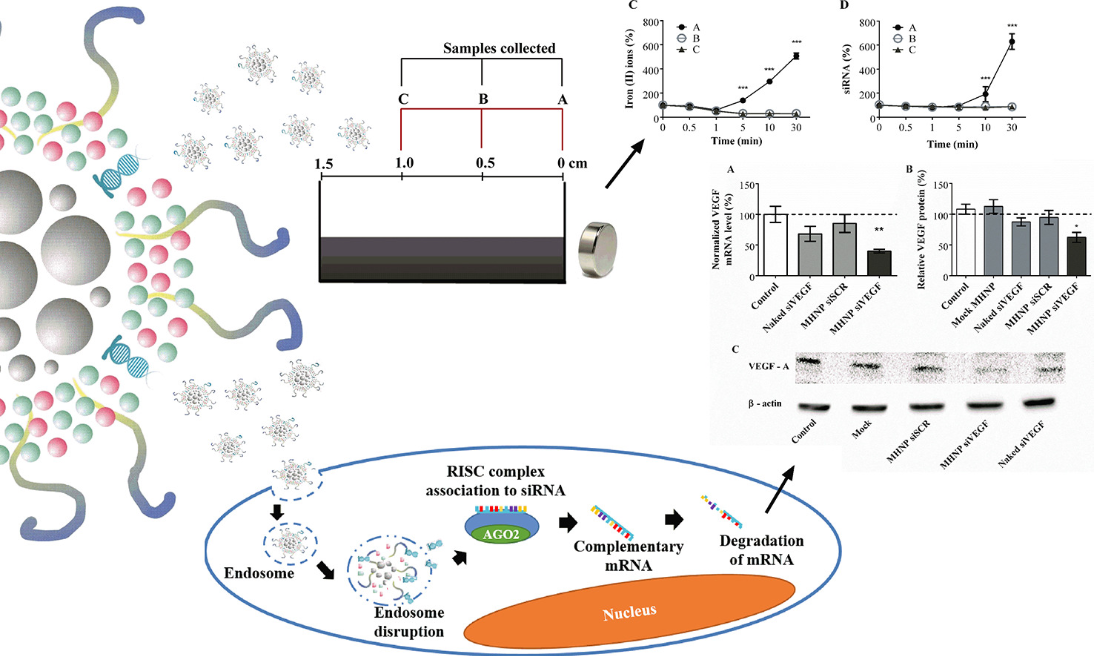Nanocarriers for the treatment of cancer through RNAi
Tumorigenesis is related to an imbalance in controlling mechanisms of apoptosis. Thus, a novel approach to suppress antiapoptotic genes is the use of small interfering RNA (siRNA) in cancer cells. With this, the development of nanostructured systems seeks to optimize the delivery of siRNA to cancer cells. To know more about this innovative system, check out the articles below.

Figure 1: Graphical abstract (artigo 1).
- DALMINA, MILENE ; PITTELLA, Frederico ; SIERRA, JELVER ALEXANDER ; SOUZA, GABRIELA REGINA ROSA ; SILVA, ADNY HENRIQUE ; PASA, ANDRÉ AVELINO ; CRECZYNSKI-PASA, TÂNIA BEATRIZ . Magnetically responsive hybrid nanoparticles for in vitro siRNA delivery to breast cancer cells. Materials Science & Engineering C-Materials for Biological Applications, 2019.
- MELLO JUNIOR, L.; SOUZA, G.R.; WINTER, E.; SILVA, A.H.;PITTELLA, F.; CRECZYNSKI-PASA, T.B. Knockdown of Antiapoptotic Genes in Breast Cancer Cells by siRNA Loaded Into Hybrid Nanoparticles. Nanotechnology (Bristol), v.28, p.175101 ,2017
- PITTELLA, F.; CABRAL, H.; MAEDA, Y.; PENG, M.; WATANABE, S.; KIM, H. J.; NISHIYAMA, N.; MIYATA, K.; KATAOKA, K. Systemic siRNA delivery to a spontaneous pancreatic tumor model in transgenic mice by PEGylated calcium phosphate hybrid micelles. Journal of Controlled Release, v.178, p.18 24, 2014.
- KIM, H.J.; TAKEMOTO, H.; YI, Y.; ZHENG, M.; MAEDA, Y.; CHAYA, H.; HAYASHI, K.; MI, P.; PITTELLA, F.; CHRISTIE, R. J.; TOH, K.; MATSUMOTO, Y.; NISHIYAMA, N.; MIYATA, K.; KATAOKA, K. Precise Engineering of siRNA Delivery Vehicles to Tumors Using Polyion Complexes and Gold Nanoparticles. ACS Nano, v.8, p.8979 8991, 2014.
Development and Optimization of Solid Lipid Nanoparticles
Nanoparticles receive increasing attention, especially in the pharmaceutical field. Lipid nanoparticles, in particular, represent promising systems to enhance the incorporation of hydrophobic compounds into the lipid matrix. During the development of the nanoparticles, it is necessary to deliver the active in a controlled manner. Thus, we do search the adequate lipid as well as the ideal surfactant for a given nanoparticle. In addition, we also adjust the release trigger in the nanoparticle, for efficient deliver of the active to desired tissue. To know more see the article below:
- SANTOS, M.; DOS SANTOS VALLE, A.B.C.; MOURA GUALBERTO, A.C.; LEITE, F.B.; PITTELLA, Frederico. Setting Precise Temperature for Triggered Release from Nanostructured Lipid Carriers. IFAC-PAPERSONLINE, v. 51, p. 1-6, 2018.
- SOLDATI, P.P.; POLONINI, H.C.; PAES, C.Q.; RESTREPO, J.A.S.; CRECZYNKSI-PASA, T.B.; CHAVES, M.G.A.M.; BRANDÃO, M.A.F.; PITTELLA, Frederico; RAPOSO, N.R.B. Controlled release of resveratrol from lipid nanoparticles improves antioxidant effect. IFAC-PAPERSONLINE, v. 51, p. 16-21, 2018.
- DAL PIZZOL, C.; FILIPPIN MONTEIRO, F.; RESTREPO, J.; PITTELLA, Frederico; SILVA, A.; SOUZA, P.A.; CAMPOS, A.M.; CRECZYNSKI-PASA, T. Influence of Surfactant and Lipid Type on the Physicochemical Properties and Biocompatibility of Solid Lipid Nanoparticles. International Journal of Environmental Research and Public Health. , v.11, p.8581 8596, 2014.
Development of Nanostructured Polymer Systems
One of the nanoparticles of great importance in pharmaceutical area is based in polymers. Due to the ease of incorporation of hydrophilic actives, we use this system for the development of formulations for photoprotection and also for wound healing.
- MONTEIRO, L. M.; TAVARES, G. D.; FERREIRA, E. I.; CONSIGLIERI, V.O.; BOUCHACRA, N. A.; LOEBENBERG, R. Reverse phase highperformance liquid chromatography for quantification of hydroxymethylnitrofurazone in polymeric nanoparticles. Brazilian Journal of Pharmaceutical Sciences (Online). , v.51, p.561 567, 2015.
